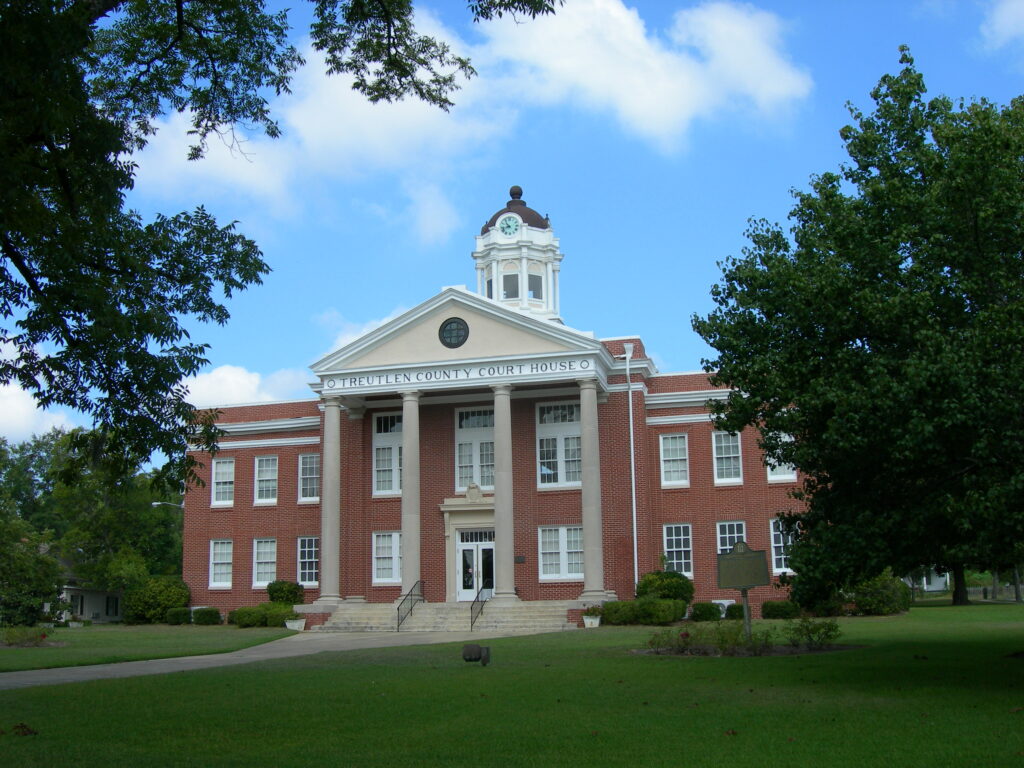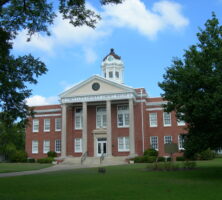Treutlen County, in central Georgia, is the state’s 154th county and comprises 201 square miles. It was created in 1918 from Emanuel and Montgomery counties, and named for John Adam Treutlen, the state’s first governor.
Its original inhabitants were Creek Indians, who lost their land in the 1773 and 1783 Indian cessions. Many of the first white settlers in the area fought in the Revolutionary War (1775-83) and came to the region after the war’s end. Attracted to the area for its wiregrass, which could be adapted to the needs of grazing livestock, they acquired land by lottery and set up subsistence farms, clearing arable land from the pine barrens that cover the county. Agriculture was soon joined by forest-related industry as an economic mainstay; the longleaf pine forests provided raw material for sawmills, turpentine stills, and cabinetmakers.
Most people lived in isolated locations due to the difficulty of building roads in the region. The development of towns was not seen until after the Civil War (1861-65), when the wiregrass region was opened up by the arrival of railroads. In 1902 the Macon, Dublin, and Savannah Railroad extended its line from Macon to Vidalia and built a depot near the town of Lothair. That same year a nearby town, named Soperton for Benjamin Franklin Soper, founder of the Southern Railway and Milling Company and a construction engineer with the Macon, Dublin, and Savannah, was incorporated. Although Lothair was, at the time, more settled than Soperton, the arrival of the railroad accelerated the growth of the newer town, which soon overtook the older community. Continued growth made Soperton the natural choice for county seat when Treutlen County was created in 1918. Its courthouse was built in 1920, renovated in 1976, and added to the National Register of Historic Places in 1980.

During the 1920s James Fowler, a local cotton farmer seeking a way to overcome the economic calamity caused by the boll weevil, planted more than 7 million pine seedlings on 10,000 acres in Treutlen County. Fowler’s work garnered national attention from those who were interested in reforestation. A Savannah scientist, Charles Herty, worked with Fowler to create newsprint from his pine trees, leading to the widespread use of paper made from pine pulp. In 1933 the Soperton News became the first paper in the United States to print the news on pine-pulp paper. The annual Million Pines Arts and Crafts Festival in Soperton, which is nicknamed the “Million Pines City,” honors Fowler and publicizes the importance of pine trees to the county’s economy. Treutlen County continued to grow until the onset of the Great Depression in 1929. At that time, a population decline set in, which was not reversed until the 1980s.
Neil Gillis, remembered as the “Father of Treutlen County,” was a local bank director and large landowner who campaigned successfully for the creation of the county. His son Jim L. Gillis served as state senator and Georgia’s highway commissioner. Interstate 16 between Macon and Savannah is called the Jim L. Gillis Highway in his honor. George Troup, governor of Georgia in the 1820s, is buried at Rosemont, his former plantation in Treutlen County.
Points of interest include the Curt Barwick House, home to the Million Pines Visitor Center in Soperton; Jean Gillis Park, site of the Dave Gillis House, the oldest log cabin in the county; and Soperton Depot, which has served as Soperton’s city hall since the early 1970s.
The Treutlen County Workforce Training Center, a satellite campus of Southeastern Technical College, offers technical certificates of credit to high school students in the county.
According to the 2020 U.S. census, the population was 6,406.






